Electric Servo Pumps
The Quantum Servo Pump Technology perfectly blends together the advantages of the two most sought after types of pumps while eliminating possible drawbacks.
Waterjet pumps come in two traditional types, direct and intensifier. They both pressurise, draw water and eject the same power by giving the piston-plunger assembly a back and forwards motion within a sealed chamber. The difference here can be found in the mechanism that drives the plunger.
As for the direct-drive models, they make use of a crankshaft whereas intensifiers utilise hydraulic cylinders instead. In contrast to this, Quantum SPT makes use of an electric servo motor that will help in driving the plungers that are linked to a reciprocating ball screw.
This level of design is more beneficial in such a way that they are at par or most of the time even work better and surpass the anticipated performance of both intensifier models and direct-drive type in many different areas.
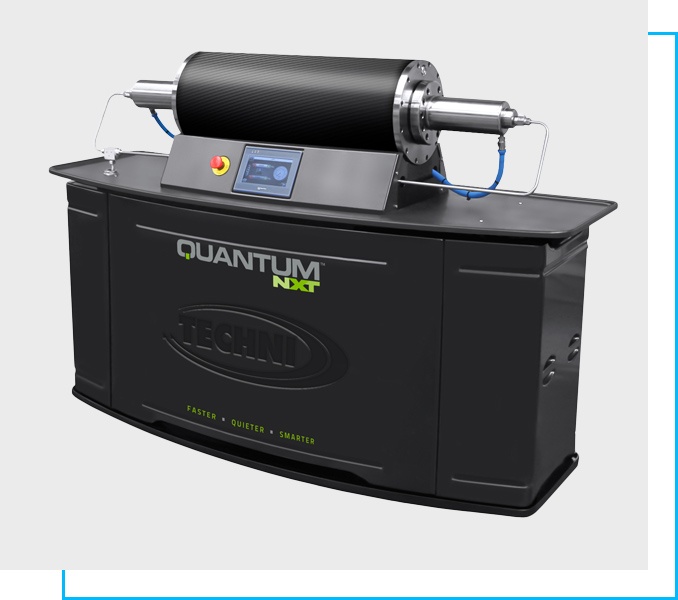

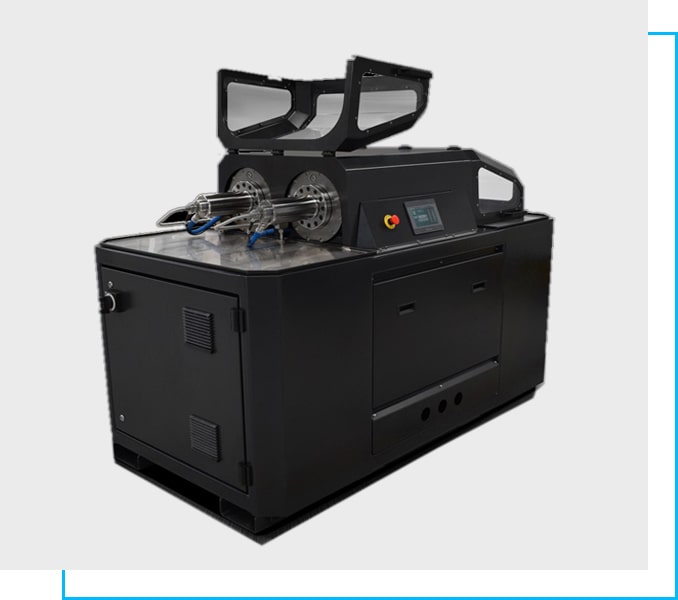
Salient Features Of The Quantum SPT™ Quantum NXT™ Water Jet Pump Series
Efficient – Quantum servo pumps utilise only its required energy for use in the cutting process. Much like how a direct-drive pump works, it is capable of directing its share of energy, produced by the motor, to produce a plunging action pressurising the water.
Varying Pressures in Multiple Heads – Both the electric servo and intensifier pumps can idle out, even without the need to lose pressure or displace water. Otherwise known as “dead-heading”, it renders these designs more appropriate for driving multiple cutting heads.
Maintenance – Much like the intensifier pumps, Quantum SPT pumps require less maintenance work which is the complete contrast on what you’ll have with direct-drive pump models. This can be attributed to the plunger speed when it reciprocates.
Footprint – The servo motor that drives the Quantum SPT pumps comes with a hollow floor space and is made to wrap around the ballscrew, minimising the required floor space for the pump. This advantage becomes more pronounced when you compare the system to intensifier pumps.
Real-Time Diagnostics – Quantum SPT servo motor provides a platform for use in giving direct feedback, much like how machine tool servos relay the positioning details to the CNC. This functionality allows operators to keep an eye on the pump’s real time operation, from the user interface.
| MODEL | 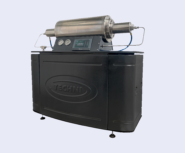 VP 15/52 VP 15/52 | 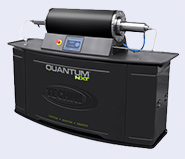 ESP 30/55HD ESP 30/55HD |  ESP 37/66 ESP 37/66 | 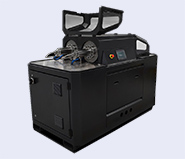 ESP 60/55HD-D ESP 60/55HD-D |  ESP 74/66-D ESP 74/66-D |
|---|---|---|---|---|---|
| Max Output Pressure (BAR) | 52,000 PSI (3585) | 55,000 PSI (3790) | 66,000 PSI (4550) | 55,000 PSI (3792) | 66,000 PSI (4550) |
| Max Output Volume (LPM) | 0.5 GPM (1.9) | 1.0 GPM (3.8) | 2.0 GPM (7.6) | ||
| Physical DimensionsL x W x H (m) | 51” (1.3) x 21” (0.5) x 42” (1.1) | 73” (1.8) x 26” (0.66) x 50” (1.27) | 79” (2.0) x 43” (1.08) x 54” (1.36) | ||
| Weight (kg) | 905 lbs (410) | 1390 lbs (630) | 3020 lbs (1370) | ||
| Max Noise Level | 68 dBA | 70 dBA | 73 dBA | ||
| Power Requirements | 3 PH 380-480 VAC, 50-60 Hz, 30 Amp | 3 PH 380-480 VAC, 50-60 Hz, 60 Amp | 3 PH 380-480 VAC, 50-60 Hz, 125 Amp | ||
| Cooling Water Requirement | 1 GPM (4 LPM) @ 68°F (20°C) | 1.6 GPM (6 LPM) @ 54°F (12°C) | 3.2 GPM (12 LPM) @ 54°F (12°C) | ||
- The technical details provided in the table above are subject to change without prior notice.
- Output volume based on 480 vac electrical supply.
The Quantum SPT™ Quantum NXT™ (Electric Servo Pump) incorporates core “direct servo” technology that was first applied by NASA for the Space Shuttle Program by replacing old-fashioned hydraulic cylinders with new, highly compact, efficient, reliable and infinitely controllable Servo Linear Actuators. This same style actuator is used today in many high-end machine tools and presses replacing inefficient hydraulic systems. Similarly, Quantum SPT™ is the first water jet pump manufacturer to utilize “direct servo” technology in an ultrahigh pressure waterjet pump and has developed patented designs to integrate the core technology into the most efficient, reliable and controllable ultra-high pressure (UHP) waterjet cutting pump.
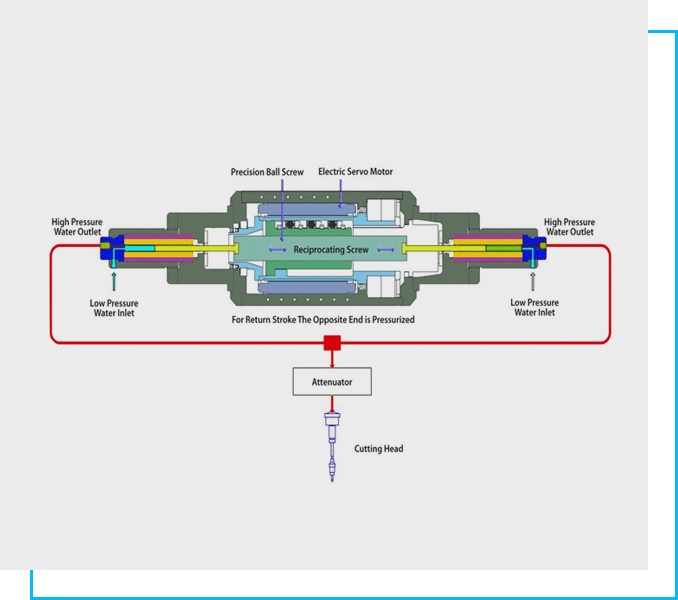
Traditional waterjet pumps are categorized into two main types – intensifier pumps and direct drive crankshaft pumps. These two types offer different benefits, but both have considerable limitations.
Intensifier waterjet pumps are capable of delivering higher operating pressures, can support multiple nozzles, and can be “dead-headed” by holding pressure without any water being displaced. While dead-heading is desirable to pause or hold the cutting operation, it results in unwanted pressure spikes of up to 10% of the operating pressure, which is harmful to components and causes failure in high pressure piping and fittings. Intensifier pumps are typically very inefficient, large and noisy.
Direct drive crankshaft pumps are smaller, quieter and more efficient, but cannot dead-head, and must displace the water whenever the motor is on, which is done by dumping the water over a relief valve to drain. As a result, it is not practical to run multiple heads or varying orifices, as the unused water and energy is wasted. Direct drive crankshaft water jet pumps are not suitable for running varying pressures, and are less reliable than intensifier pumps due to their high plunger piston speeds.
The Quantum SPT™ Quantum NXT™ takes advantage of all the best features of the two existing technology pumps, while having none of their limitations.
The Quantum SPT™ Quantum NXT™ is by far the most efficient water jet pump available on the market, delivering real efficiency gains and real savings. Direct drive crankshaft waterjet pumps have traditionally been marketed for their efficiency, however, they are only efficient while the cutting head is open and the full capacity of the pump is being used. When the head closes while the material is being loaded, unloaded, and re-loaded, or while the machine positions for the next cut, almost all of the energy is directed over a relief valve, literally sending power, water and money down the drain. Intensifier water jet pumps are inherently less efficient due to the power required to simply run the hydraulic system. They also use a large percentage of their power regardless whether cutting or idle, as the hydraulic oil is passed over a relief valve in the hydraulic system. The Quantum NXT™ only ever uses the power required for the cutting process. This means that regardless of whether the cutting head is open or closed, or the pressure or flow is reduced, there are no additional power losses.
Duty cycles equate to the percentage of time that the cutting head is open, cutting, and actually removing material. As with any profile cutting machine, a percentage of time is used to positioning the head between cuts and while sheets are being loaded and unloaded. Typical duty cycles range from 90% for heavy plate cutting, down to 20% for plastics, foams and automotive trim components. Most common waterjet applications such as metal cutting, fabrication, stone cutting, and glass cutting run at about 60% duty cycle.
Reducing the Carbon Footprint with Quantum SPT™ Quantum NXT™
The Quantum SPT™ Quantum NXT™ is the most environmentally friendly, has the least affect on global warming, and has the smallest carbon footprint of any waterjet cutting pump available on the market.
The high level of efficiency achieved by the Quantum NXT™ dramatically reduces the energy consumed and the water required. For example, a typical company running a single head waterjet cutting machine with the Quantum NXT™, for a single shift for a year, will save approximately 32,000 kW hrs, saving around $6,080/year in electricity charges, and reducing harmful CO2 green house gases by a staggering 20 tons/yr. There are also considerable water consumption savings as a result of the increased efficiency. For the same example, savings of approximately 290,000 gallons/yr can be achieved, resulting in savings of around $3,019/year.
*Figures are based on a comparison with a typical 50 hp intensifier pump running at 60% duty cycle.

